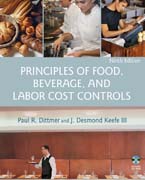
Separated into four parts including an introduction to food, beverage, and labor cost controls followed by separate sections each devoted to food, beverage, and labor, this classic text has been updated in this new Ninth Edition. In this new edition, key terms, key concepts, review questions, and spreadsheet exercises reinforce and support readers' understanding. It also features increased discussion and examples of technology use in food and beverage operations,a running case study, and a separate chapter on menu analysis and engineering. This text is well suited for classroom, professional training, and on-the-job use. INDICE: Preface. PART I. INTRODUCTION TO FOOD, BEVERAGE, AND LABOR CONTROLS. Chapter 1. Cost and Sales Concepts. Introduction. Cost Concepts. Sales Concepts. The Cost-to-Sales Ratio: Cost Percent. Chapter Essentials. Key Terms in this Chapter. Questions and Problems. Excel Exercises. Chapter 2. The Control Process. Introduction. Control. The Control Process. Control Systems. Cost/Benefit Ratio. Chapter Essentials. Key Terms in this Chapter. Questions and Problems. Excel Exercises. Chapter 3. Cost/Volume/Profit Relationships. Introduction. The Cost/Volume/Profit Equation. Variable Rate and Contribution Rate. Break-Even Point. Cost/Volume/Profit Calculations for the Grandview Bistro. Cost Control and the Cost/Volume/Profit Equation. Chapter Essentials. Key Terms in this Chapter. Questions and Problems. Excel Exercises. PART II. FOOD CONTROL. Chapter 4. Food Purchasing and Receiving Control. Introduction. The Control Process-Purchasing and Receiving. Developing Standards and Standard Procedures forPurchasing. Standing Orders. Receiving Controls. Establishing Standard Procedures for Receiving. Chapter Essentials. Key Terms in this Chapter. Questions and Problems. Excel Exercises. Chapter 5. Food Storing and Issuing Control. Introduction. Storing Control: Establishing Standards and Standard Procedures forStoring. Issuing Control: Establishing Standards and Standard Procedures for Issuing. Food and Beverage Transfers. Chapter Essentials. Key Terms in this Chapter. Questions and Problems. Excel Exercises. Chapter 6. Food Production Control I: Portions. Introduction. Establishing Standards and Standard Procedures. Calculating Standard Portion Costs. Advantages and Disadvantages of Standardized Yield. Using Yield Percentages. Recipe Software. Chapter Essentials. Key Terms in this Chapter. Questions and Problems. Excel Exercises. Chapter 7. Food Production Control II: Quantities. Introduction. Establishing Standards and Standard Procedures. Determining Production Quantities. Control of Preportioned Entrées. A Word of Caution. Chapter Essentials. Key Terms in this Chapter. Questions and Problems. Excel Exercises. Chapter 8. Monitoring Foodservice Operations I: Monthly Inventory and Monthly Food Cost. Introduction. Monthly Inventory. Reports to Management. Inventory Turnover. Chapter Essentials. Key Termsin this Chapter. Questions and Problems. Excel Exercises. Chapter 9. Monitoring Foodservice Operations II: Daily Food Cost. Introduction. Determining DailyFood Cost. Book versus Actual Inventory Comparison. Chapter Essentials. Key Terms in this Chapter. Questions and Problems. Excel Exercises. Chapter 10. Monitoring Foodservice Operations III: Actual versus Standard Food Costs. Introduction. Determining Standard Cost. Comparing Actual and Standard Costs. Periodic Comparison. Chapter Essentials. Key Terms in this Chapter. Questions and Problems. Excel Exercises. Chapter 11. Menu Engineering and Analysis. Introduction. Menu Engineering. Menu Analysis. Using 100 Percent of the Average for Number Sold. Chapter Essentials. Key Terms in this Chapter. Questions and Problems.Excel Exercises. Chapter 12. Controlling Food Sales. Introduction. The Goals of Sales Control. Optimizing Number of Customers. Maximizing Profit. Controlling Revenue. Revenue Control Using Manual Means. Revenue Control Using Computers. Chapter Essentials. Key Terms in this Chapter. Questions and Problems. PARTIII. BEVERAGE CONTROL. Chapter 13. Beverage Purchasing Control. Introduction.Control Process and Purchasing. Alcoholic Beverages. Nonalcoholic Beverages. Beverage Purchasing. Chapter Essentials. Key Terms in this Chapter. Questions and Problems. Excel Exercises. Chapter 14. Beverage Receiving, Storing, and Issuing Control. Introduction. Receiving. Storing. Issuing. Chapter Essentials. Key Terms in this Chapter. Questions and Problems. Excel Exercises. Chapter 15. Beverage Production Control. Introduction. Objectives of Beverage ProductionControl. Establishing Standards and Standard Procedures for Production. Chapter Essentials. Key Terms in this Chapter. Questions and Problems. Excel Exercises. Chapter 16. Monitoring Beverage Operations. Introduction. The Cost Approach. The Liquid Measure Approach. The Sales Value Approach. Inventory Turnover.Chapter Essentials. Key Terms in this Chapter. Questions and Problems. Excel Exercises. Chapter 17. Beverage Sales Control. Introduction. The Objectives ofBeverage Sales Control. Guest Checks and Control. Chapter Essentials. Key Terms in this Chapter. Questions and Problems. PART IV. LABOR CONTROL. Chapter 18. Labor Cost Considerations. Introduction. Employee Compensation. Determinantsof Total Labor Costs and Labor Cost Percents. Labor Cost Control. Chapter Essentials. Key Terms in this Chapter. Questions and Problems. Excel Exercises. Chapter 19. Establishing Performance Standards. Introduction. Establishing Performance Standards and Standard Procedures. Organizing the Enterprise. Preparing Job Descriptions. Scheduling Employees. Performance Standards Based on Test Period. Standard Staffing Requirements. Standard Work Hours. Standard Cost. Chapter Essentials. Key Terms in this Chapter. Questions and Problems. Excel Exercises. Chapter 20. Training Staff. Introduction. A Definition of Training. The Purpose of Training. The Training Program. Centralized versus Localized Training. Training Manuals. Chapter Essentials. Key Terms in this Chapter. Questions and Problems. Excel Exercises. Chapter 21. Monitoring Performance and Taking Corrective Action. Introduction. Monitoring Performance. Taking Corrective Action to Address Discrepancy between Standards and Performance. Chapter Essentials. Key Terms in this Chapter. Questions and Problems. Excel Exercises. Glossary.
- ISBN: 978-0-471-78347-3
- Editorial: John Wiley & Sons
- Encuadernacion: Cartoné
- Páginas: 648
- Fecha Publicación: 10/10/2008
- Nº Volúmenes: 1
- Idioma: Inglés
